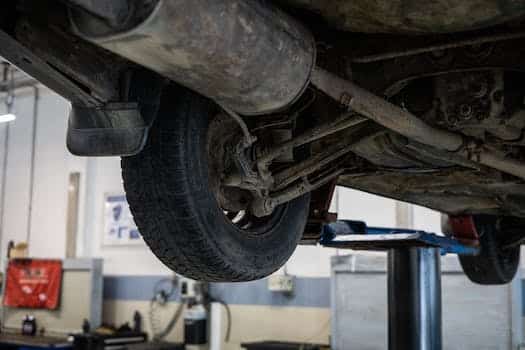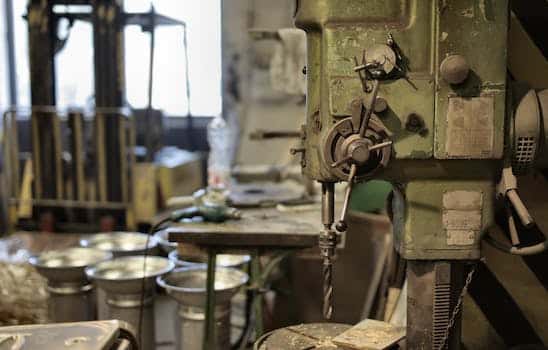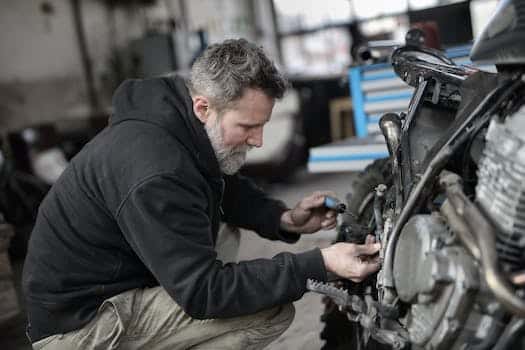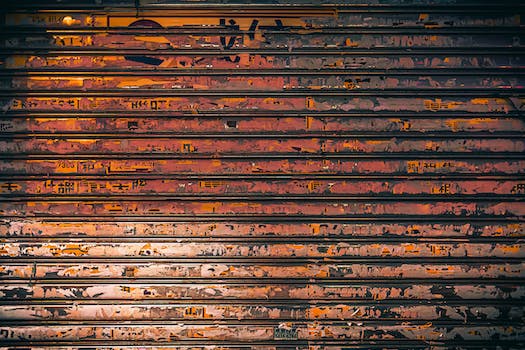To fix a garage door, follow these steps:
1. Inspect the tracks: Check the tracks for any bends, dents, or obstructions. If you notice any, use a rubber mallet to gently tap them back into shape or call a professional for repairs.
2. Tighten loose hardware: Ensure that all the bolts, nuts, and screws securing the garage door are tightened. Loose hardware can cause the door to malfunction.
3. Lubricate moving parts: Apply lubricant to all the moving parts of the garage door, including hinges, rollers, and springs. This helps reduce friction and ensures smoother operation.
4. Check the balance: Disconnect the garage door opener and manually raise the door halfway. If it doesn’t stay in place, the door may be unbalanced. To fix this, adjust the tension on the springs or call a professional.
5. Test the safety features: Test the safety sensors and auto-reverse feature, if your door has them. Place an object in the path of the door and close it. The door should automatically reverse if it detects an obstruction. If it doesn’t, realign the sensors or consult a technician.
6. Replace damaged weatherstripping: Weatherstripping seals the edges of the door to prevent drafts and pests from entering the garage. If it’s damaged or worn out, remove the old weatherstripping and install new ones.
7. Replace worn-out rollers: If the rollers are cracked, chipped, or worn out, they may hinder the smooth functioning of the door. Remove the old rollers and replace them with new ones to ensure proper operation.
8. Inspect the springs: Garage door springs are under high tension and can be dangerous to handle. If you notice any issues with the springs, such as rust, damage, or wear, it’s best to hire a professional to replace them.
9. Test the opener: If your garage door opener is not working correctly, inspect the batteries in the remote control. If the batteries are fine, check the power source and consult the opener’s manual for troubleshooting tips.
Remember, if you are unsure about any aspect of garage door repairs, it is always best to seek professional assistance to ensure safety and correct repair. 
Common Garage Door Problems and How to Fix Them
Garage doors are an essential part of our homes, providing security and convenience. However, like any mechanical system, they can sometimes experience issues that need to be addressed. In this article, we will explore some of the most common garage door problems and provide solutions on how to fix them.
1. The Door Won’t Open or Close
One of the most frustrating problems homeowners face is when their garage doors refuse to open or close. This can be caused by a variety of factors, such as a malfunctioning remote control, damaged cables, or misaligned sensors.
To fix this issue, start by checking the batteries in your remote control. Make sure they are functioning properly and replace them if necessary. If the remote control is not the problem, examine the cables for any signs of fraying or damage. If you notice any issues, it is best to call a professional garage door repair service to handle the repair.
In some cases, misaligned sensors may be preventing the door from opening or closing. Check if there is any debris blocking the sensors and clean them carefully. If the problem persists, consult a technician to realign the sensors for you.
2. The Door Makes Excessive Noise
If your garage door is making loud or excessive noise when opening or closing, it may be due to worn-out rollers, loose hardware, or lack of lubrication.
Start by inspecting the rollers. If they appear worn or damaged, they will need to be replaced. Additionally, tighten any loose hardware, such as bolts or screws, to reduce noise. Lastly, lubricate all moving parts using a silicone-based lubricant to ensure smooth operation.
3. The Door Is Off-Track
An off-track garage door is not only inconvenient but also poses a safety hazard. If your door is off-track, do not attempt to fix it yourself as it can lead to further damage and potential injuries.
Call a professional garage door repair service to handle this issue. They have the knowledge and tools to safely realign the door and ensure it operates smoothly once again.
4. The Door Closes Partially and Then Reverses
If your garage door closes partially and then immediately reverses, it indicates a problem with the door’s safety sensors. These sensors are designed to prevent accidents by detecting any obstructions in the door’s path.
To fix this issue, start by cleaning the sensors and ensuring they are properly aligned. Remove any debris or objects that may be blocking the sensors’ line of sight. If the problem persists, consult a professional technician to inspect and repair the safety sensors.
5. The Door Springs Are Broken
Garage door springs play a crucial role in the door’s functioning, helping to balance its weight and facilitate smooth operation. If you notice that the springs are broken, it is important to address this issue promptly.
Broken springs can be dangerous to handle and should only be repaired or replaced by a professional. Contact a reputable garage door repair service to have your springs inspected and replaced, ensuring the safe operation of your garage door.
In conclusion, garage door problems can be frustrating, but they are not insurmountable. By identifying the issue and taking the appropriate steps to fix it, you can ensure that your garage door functions properly and continues to provide security and convenience for your home.
- Inspect the batteries in your remote control.
- Check the cables for any signs of damage or fraying.
- Clean and realign the sensors.
- Replace worn-out rollers and tighten loose hardware.
- Call a professional for off-track doors or broken springs.

Step-by-Step Guide to Repairing a Garage Door
Having a malfunctioning garage door can be a frustrating experience. Not only does it hinder your daily routine, but it also poses a security risk. Instead of calling a professional and spending a fortune on repairs, you can try fixing it yourself. In this article, we will provide you with a step-by-step guide to repairing a garage door. Follow these simple instructions and get your garage door working flawlessly again.
Gather the Necessary Tools and Materials
Before you start repairing your garage door, make sure you have all the necessary tools and materials. Here is a list of items you will need:
- Screwdriver set
- Adjustable wrench
- Pliers
- Cordless drill
- New garage door springs
- Replacement rollers
Identify the Problem
The first step in repairing a garage door is identifying the problem. There could be various issues causing your door to malfunction, such as broken springs, damaged rollers, or misaligned tracks. Carefully inspect your garage door and determine the exact problem.
If you notice that the door is not opening or closing smoothly, chances are the springs are broken and need to be replaced. On the other hand, if the door is making a grinding noise, it could be due to damaged rollers. Misaligned tracks can cause the door to get stuck or operate unevenly.
Replace Broken Springs
If you find that the springs are broken, you will need to replace them. Here is a step-by-step guide to replacing garage door springs:
- Disconnect the garage door opener.
- Release the tension in the springs.
- Remove the old springs.
- Install the new springs.
- Reattach the garage door opener.
Replacing garage door springs can be dangerous, so it is recommended to follow these steps carefully or seek professional assistance.
Fix Damaged Rollers
If you have determined that the rollers are damaged, follow these steps to fix them:
- Disconnect the garage door opener.
- Remove the roller brackets.
- Replace the damaged rollers with new ones.
- Reattach the roller brackets.
- Reconnect the garage door opener.
Make sure to use high-quality replacement rollers for optimal performance and longevity.
Adjust Misaligned Tracks
In case your garage door is getting stuck or operating unevenly due to misaligned tracks, here is how you can adjust them:
- Disconnect the garage door opener.
- Loosen the screws holding the tracks in place.
- Gently tap the tracks with a hammer to align them.
- Tighten the screws to secure the tracks.
- Reconnect the garage door opener.
By following these simple steps, you can ensure that your garage door operates smoothly and efficiently.
Conclusion
Repairing a garage door doesn’t always require professional help. By following this step-by-step guide, you can fix common issues and get your garage door back in working order. Remember to always prioritize safety and follow the instructions carefully. With the right tools and a bit of patience, you can save money on repairs and maintain your garage door’s functionality in the long run.

Tools and Materials Needed for Garage Door Repairs
Garage doors are an essential part of our homes, providing security and convenience. However, like any other mechanical system, they can sometimes break down and require repairs. In this article, we will discuss the tools and materials needed for garage door repairs.
When it comes to fixing a garage door, having the right tools is crucial. Here are some essential tools you should have:
| Tool | Description |
|---|---|
| Screwdriver | A screwdriver is used to remove screws and panels on the garage door. |
| Adjustable Wrench | An adjustable wrench is needed to tighten or loosen nuts and bolts. |
| Pliers | Pliers are used for gripping and pulling wires or small components. |
| Hammer | A hammer is necessary for tapping and aligning misaligned parts. |
| Tape Measure | A tape measure is used to take accurate measurements for replacement parts. |
Apart from the tools mentioned above, there are some materials you should have on hand for garage door repairs. These materials include:
- Replacement Springs: Garage door springs are essential for the proper functioning of the door. Having replacement springs of the correct size is necessary in case the existing ones break.
- Cables and Rollers: Cables and rollers are crucial components that ensure smooth and balanced movement of the door. It is recommended to have spare cables and rollers in case they wear out or get damaged.
- Hinges and Brackets: Hinges and brackets play a significant role in the stability and proper functioning of the garage door. Keeping spare hinges and brackets can be handy in case any of them break or become loose.
- Track Lubricant: Applying lubricant to the tracks can help reduce friction and ensure smooth movement of the garage door. It is advisable to have track lubricant readily available for regular maintenance.
In conclusion, having the right tools and materials is crucial for effective garage door repairs. By keeping these essential items on hand, you can address common issues and ensure the optimal functioning of your garage door. Remember to follow safety precautions and consult a professional if you’re unsure about any repair task. With the right tools, materials, and knowledge, you can save time and money by performing minor repairs on your own.

Safety Tips for DIY Garage Door Fixes
Garage doors are an essential part of our homes, ensuring the safety and security of our vehicles and belongings. However, problems with garage doors can arise from time to time, and knowing how to fix them can save you time and money. If you’re planning on tackling a garage door repair yourself, it’s crucial to follow these safety tips to ensure a successful and accident-free outcome.
1. Wear Protective Gear
Before you start any DIY garage door fix, make sure you’re wearing the appropriate protective gear. This includes safety goggles, gloves, and sturdy shoes. Garage doors are heavy and can cause serious injuries if mishandled, so protect yourself from any potential accidents.
2. Familiarize Yourself with the Garage Door Parts
Understanding the different components of a garage door is essential for a successful repair. Take the time to familiarize yourself with parts like springs, rollers, tracks, and cables. This knowledge will help you identify and address the root cause of the problem.
3. Disconnect the Power
Before starting any repair work, always disconnect the power to the garage door opener. This will prevent accidental openings or closings while you’re working on it and reduce the risk of electrical shocks.
4. Use Proper Tools
Ensure you have the necessary tools for the job before you begin. Using the wrong tools can lead to further damage and potential accidents. Some commonly used tools for DIY garage door repairs include wrenches, pliers, screwdrivers, and a hammer.
5. Follow Manufacturer Instructions
Every garage door repair may have specific instructions provided by the manufacturer. Ensure you carefully read and follow these instructions to avoid any complications or damage. This will also help you understand the limitations of your DIY repair and when it’s best to call a professional.
6. Be Cautious of Torsion Springs
Torsion springs are under high tension and can cause severe injuries if mishandled. If you suspect a problem with the torsion springs, it’s best to leave it to the professionals. Attempting to fix or replace them yourself can lead to serious accidents.
7. Know Your Limits
While DIY garage door repairs can save you money, it’s important to know your limits. If the issue seems complex or beyond your expertise, don’t hesitate to call a professional. It’s better to invest in professional help than risk further damage or potential injuries.
Conclusion
By following these safety tips, you can confidently undertake DIY garage door fixes while ensuring your well-being. Remember to prioritize your safety, wear protective gear, and know when to seek professional assistance. With the right approach and precautions, you can successfully address common garage door issues and maintain the security of your home.

Signs That You Need to Call a Professional for Garage Door Repair
Having a garage door that functions properly is crucial for the safety and security of your home. However, like any mechanical system, garage doors can experience issues over time. While minor problems can often be fixed by homeowners, there are certain signs that indicate the need to call a professional for garage door repair.
One of the most common signs that your garage door needs repair is excessive noise. If you notice squeaking, grinding, or banging noises when opening or closing the door, it could be a red flag. These noises could indicate loose hardware, worn-out rollers, or misalignment of the tracks. It is important not to ignore these sounds, as they could lead to further damage if not addressed promptly.
Another sign to look out for is slow or uneven movement of the garage door. A garage door should open and close smoothly without any delays or jerking motions. If you notice that your door is moving slower than usual or if it hesitates while opening or closing, it is advisable to call a professional. These issues could be caused by problems with the springs, cables, or motor, which require the expertise of a trained technician to fix.
| Signs That You Need to Call a Professional for Garage Door Repair | ||
|---|---|---|
| Excessive noise | Slow or uneven movement | Door not opening or closing fully |
| Door reversing unexpectedly | Visible damage or wear | Difficulty in manual operation |
In addition, if your garage door is not opening or closing fully, it is a clear indication of a problem that requires professional attention. This issue can be caused by a variety of factors, such as a malfunctioning sensor, a broken spring, or an alignment problem. A professional garage door technician will be able to diagnose the problem accurately and provide the necessary repairs.
Another sign that your garage door needs repair is if it reverses unexpectedly during operation. A garage door should remain fully open or closed until instructed otherwise. If your door reverses without any command or if it reverses immediately after touching the floor, it indicates a safety concern that needs to be addressed by a professional.
Visible damage or wear on your garage door should also not be ignored. This includes dents, cracks, rust, or sagging sections. These issues not only affect the appearance of your door but can also compromise its function and security. A professional garage door repair service can assess the damage and recommend the appropriate solutions, whether it’s panel replacement or overall door replacement.
Lastly, if you experience difficulty in manually operating your garage door, it is a sign that you need professional help. This could indicate a problem with the garage door springs, which are under high tension and should only be handled by experts trained in garage door repair.
Overall, it is important to pay attention to these signs and not attempt to fix complex garage door issues on your own. Calling a professional for garage door repair ensures the problem is addressed correctly and helps to maintain the longevity and functionality of your garage door.




